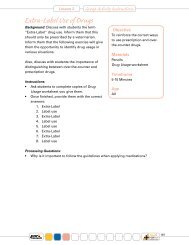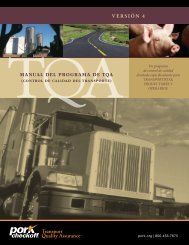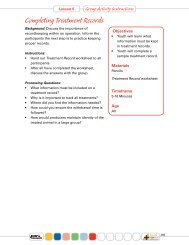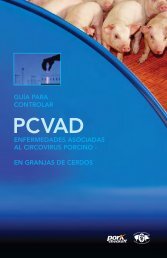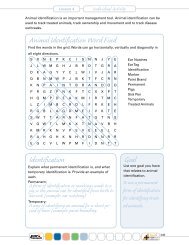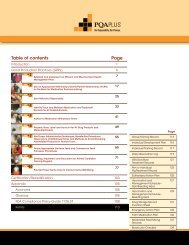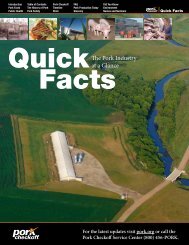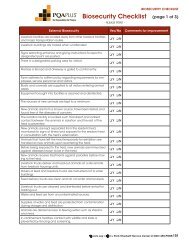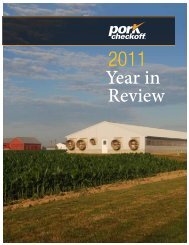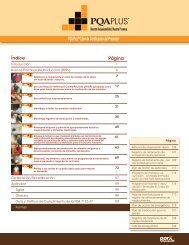PRRS Compendium Producer Edition - National Pork Board
PRRS Compendium Producer Edition - National Pork Board
PRRS Compendium Producer Edition - National Pork Board
Create successful ePaper yourself
Turn your PDF publications into a flip-book with our unique Google optimized e-Paper software.
intestine, liver, and occasionally in the brain (Halbur et al., 1996; Rossow et al., 1999). When performing antigen<br />
detection tests, such as FA and IHC, laboratories must choose whether to test for the US or European<br />
<strong>PRRS</strong> virus. Veterinarians should familiarize themselves with their local laboratory to understand which<br />
test should be run.<br />
Genetic-based testing for <strong>PRRS</strong> virus<br />
Polymerase chain reaction (PCR)-based tests have been developed for detecting <strong>PRRS</strong> virus RNA in clinical<br />
specimens. Since the virus does not need to be isolated in cell culture to detect the viral RNA, PCR can be<br />
performed in a shorter amount of time than virus isolation. As a general principle, PCR-based assays are<br />
believed to be highly sensitive and highly specific (Benson et al., 2002; Horter et al 2002).<br />
Several types of PCR-based assays have been developed, most being designed to detect regions of the<br />
virus called ORF7, ORF6 or ORF1b and can be run directly on diagnostic specimens (Chen and Plagemann<br />
1995; Christopher-Hennings et al., 1995a; Cook and Spatz, 1998; Egli et al., 2001; Gilbert et al., 1997; Legeay<br />
et al., 1997; Mardassi et al., 1994; Oleksiewicz et al., 1998, Shin et al., 1997; Spagnuolo-Weaver et al., 1998;<br />
Suarez et al., 1994; Van Wonsel et al., 1994). Some PCR assays use a “nested” procedure (RT-nPCR) for<br />
added sensitivity. More recently, automated fluorogenic PCR-based tests, such as the TaqMan TM PCR (Egli<br />
et al., 2001; Spagnuolo-Weaver et al., 2000) or “Molecular Beacon” PCR (Carlson et al., 2002) have been<br />
developed for detecting <strong>PRRS</strong> virus in clinical specimens. These PCRs are believed to improve the reliability<br />
and consistency of conventional PCR tests for <strong>PRRS</strong> virus detection.<br />
Historically, the primary diagnostic application of <strong>PRRS</strong> RT-PCR has been for the detection of virus in boar<br />
semen (Christopher-Hennings et al., 1995a, 1995b, 1996; Shin et al., 1997). PCR is particularly useful for the<br />
detection of virus in samples like semen or feces because these samples are difficult to analyze by traditional<br />
methods. It has also been found useful for detection of <strong>PRRS</strong> virus in fetal tissues and thoracic fluids<br />
(Benson et al., 2002). The use of PCR assays has become more common both for the diagnosis of <strong>PRRS</strong><br />
and to aid in herd monitoring, i.e., screening of replacement animals, detection of persistently infected animals,<br />
and test and removal programs (Bierk et al., 2001; Dee et al., 2001a; Horter et al., 2002; Kleiboeker et<br />
al., 2002). The performance of PCR testing among different laboratories may vary depending upon sample<br />
condition, sample processing, laboratory technique, and the skills and experience of the technician performing<br />
the assay. Therefore, it is important for laboratories performing PCR to validate their assays and<br />
provide this information to producers and veterinarians using their specific PCR test.<br />
Assays for Detection of Serum Antibodies (Serology)<br />
The indirect fluorescent antibody (IFA) test, serum virus neutralization (SVN) test, immunoperoxidase<br />
monolayer assay (IPMA), and enzyme-linked immunosorbent assay (ELISA) have all been used for the detection<br />
of antibodies specific for <strong>PRRS</strong> virus. The IFA, SVN, and ELISA are currently available in most North<br />
American veterinary diagnostic laboratories, while IPMA has been extensively used in Europe.<br />
The IFA is thought to have high specificity (99.5%) but unknown sensitivity for individual animals (Yoon<br />
et al., 1992a). An advantage of the IFA test compared to ELISA is that the magnitude of the antibody titer<br />
can be determined. An antibody titer of 16 or 20, depending upon the initial serum dilution for the test, is<br />
considered positive. The IFA reliably detects specific antibodies for 2 to 3 months after infection (Frey et<br />
al., 1992; Yoon et al., 1995b). Test results or endpoint antibody titers will vary depending on the degree to<br />
which the <strong>PRRS</strong> virus strain used in the assay differs from the isolate that infected the pig (Bautista et al.,<br />
1993a).<br />
The IPMA is also considered to be a highly specific and sensitive test (Wensvoort et al., 1991). In one comparative<br />
study, the sensitivity of IPMA was better than that of a commercial ELISA (Drew, 1995). Antibodies<br />
to <strong>PRRS</strong> virus are usually detected by IPMA between 7-15 days after infection (Ohlinger et al., 1992;<br />
Wensvoort et al., 1991). Like the IFA, IPMA also reliably detects specific antibodies for 2 to 3 months after<br />
infection (Frey et al., 1992; Ohlinger et al., 1992; Yoon et al., 1995a). The relatedness of the virus strain used<br />
in the assay and the virus strain infecting the pig will likely affect the performance of the IPMA test (Wensvoort<br />
et al., 1992).<br />
The ELISA is also reported to be sensitive and specific (Albina et al., 1992, Edwards et al., 1994; Nodelijk<br />
et al., 1996; O’Connor et al., 2002; Takikawa et al., 1996). One disadvantage of the ELISA format reported<br />
PAGE 40 PIG 04-01-09





